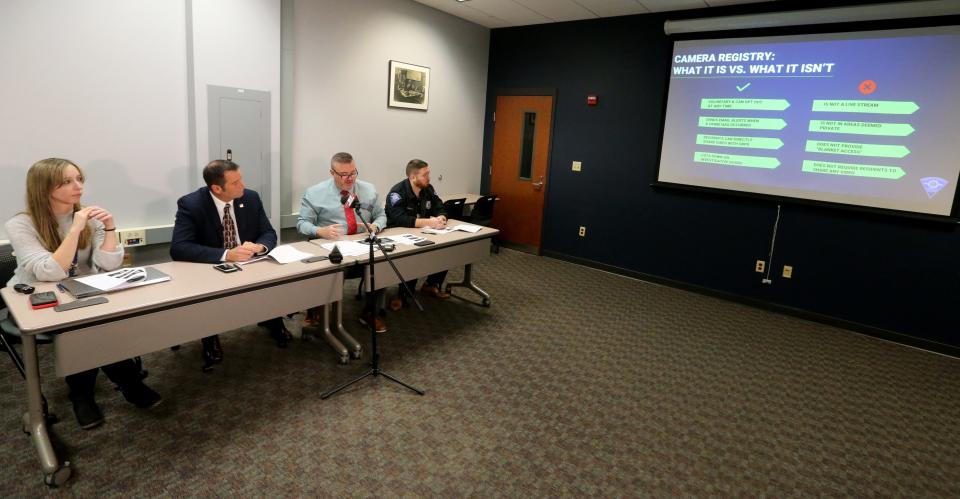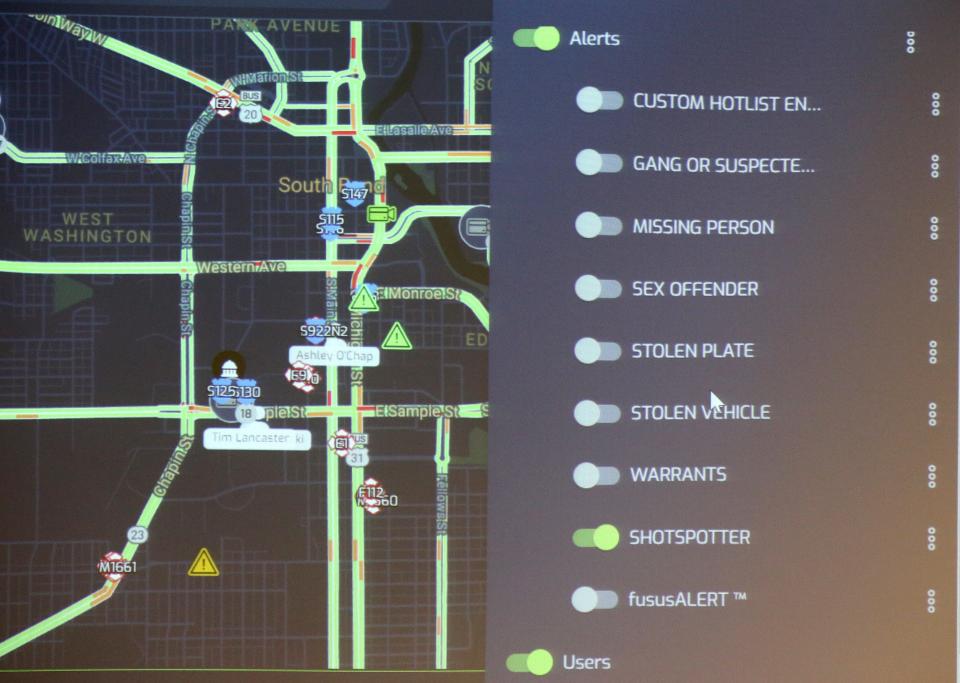South Bend police roll out 'Real Time Crime Center' technology. Some worry about privacy.

SOUTH BEND — Blue, badge-shaped icons whiz around a map of South Bend as yellow caution symbols pop up to display information about traffic accidents and robberies. The interactive screen also prominently features numerous camera icons that can be clicked on to get live video feeds from across the city.
The display seems like something out of a Jason Bourne movie, yet as of mid-December, all South Bend police officers now have access to the Fusus app as part of the department’s shift to a “Real Time Crime Center.”
Announced earlier this year by Mayor James Mueller, the South Bend Police Department recently rolled out the new public safety system and is now using the technologies integrated into the Fusus app in its everyday operations. Officials also say there will be a room full of monitors that crime analysts will use as the “center” of the Real Time Crime Center.
“All these different things where you had to do your account, do your password for each one of those, Fusus brings those all together in one fell swoop,” South Bend Police Chief Scott Ruszkowski said.
City officials say the new systems will reduce violent crime and help police bring perpetrators to justice more effectively. The project also will see the introduction of facial recognition technology, and some officials have expressed concerns about the necessity of increased surveillance systems. The Board of Public Safety last month approved policies for the center and its technologies, meaning South Bend police are able to move forward.
What is the crime center?
Though it's often referred to under the umbrella term Real Time Crime Center, the project incorporates a few different elements with a focus on an overall increase in surveillance technology. The first is an effort to expand the number of video cameras available to the police force. Starting this month, the feeds from those cameras, along with various other technology systems, go into a central hub that officers and analysts can monitor in real time.

The city has contracted with Fusus, which specializes in cloud-based policing technology, to run the system for the cost of around $125,000 a year.
The city has a number of existing surveillance cameras — such as traffic cameras that scan license plates for stolen vehicles or cars that are registered to people with warrants, as well as video feeds set up in city parks. Those cameras are now accessible by officers and analysts through the Fusus system.
On top of those pre-existing cameras, the city is undertaking a number of initiatives to increase the number of camera feeds available to police, including:
Installing more city-owned cameras in public areas to record video, but not audio, footage
Launching a pilot program where businesses will install cameras at their stores and give police access to feeds
Setting up a website where homeowners can register doorbell cameras and share footage with police
Police officials say, and some studies agree, that the expanded number of cameras will help officers investigate incidents more effectively. For instance, Assistant Police Chief Tim Lancaster said, detectives currently spend a lot of time going door-to-door to see if anyone witnessed a crime, but that time can be better spent elsewhere if residents are able to send in video footage of incidents online.
Deal reached:South Bend, police union say new contract could lead to fully-staffed department by 2024
The cameras also will help officers responding to active calls, police say, as crime analysts can view feeds and direct units on what to look for when they arrive.
“Let’s say a business is having a robbery in progress,” Lancaster said. “In the Real Time Crime Center, they can pull up that video … They would relay to the officers responding that, ‘Hey we have a person at the counter in blue jeans and a red sweatshirt. They’re holding a gun.’ The officers responding, then they know as they’re responding what they’re looking for.”
The city is currently reaching out to businesses about the pilot program, modeled after Detroit’s Project Greenlight. Police officials have said they are trying to get buy-in from businesses in areas where there have been instances of violent crime and hope to integrate those cameras into the city’s system in the new year.
“We’ve had conversations with a number of business owners and there seems to be a lot of interest in the program,” Mueller said in November. “We expect a large number of businesses to sign up.”

In addition to the cameras, the Fusus hub incorporates various systems — including ShotSpotter technology, active dispatches, GPS of on-duty officers and medics, and even traffic and weather patterns — onto one interface.
The police department also will employ facial recognition technology as part of the new public safety system, though officials have been keen to emphasize facial recognition will be used only in investigations involving violent crimes such as murder, assault or robbery. Even then, facial recognition can only be used as “lead only,” meaning it can’t be used as the sole basis for probable cause to make an arrest or to obtain a warrant.
Policies approved
The police department’s rollout of the Real Time Crime Center comes after the policies governing the new technologies were approved by the Board of Public Safety by a 3-1 vote in late November.
Darryl Heller, the sole board member who did not vote to approve the measures, raised concerns about the efficacy of video surveillance as well as the use of facial recognition, which he has called “notoriously biased.”

“I think that what it adds is insufficient to the potential harm that could arise from it,” Heller said in October, noting that facial recognition software has been shown to misidentify minorities at a higher rate than white faces.
Studies on the subject also are unclear as to whether more cameras equals less crime. One academic study conducted by Michigan State University on Project Greenlight showed "no measurable change in violent crime" though shootings in Detroit as a whole decreased from 2011 to 2019.

The study did show an increase in property and disorder crimes at Greenlight-affiliated locations, though the apparent increase in crime was likely due to increased reporting of incidents, rather than a true rise.
The study does highlight a 46% drop in carjackings at Project Greenlight locations, suggesting the cameras acted as a deterrent.
Other board members, however, said the technology is a step in the right direction.
Student resource officers:South Bend to keep SROs. Here's how board members voted in split decision.
“Overall, I think this is a good thing to use to fight crimes that occur and we want to solve them. It needs vigilance to keep monitoring to make sure it’s not used in the wrong way,” said Al Kirsits, a former South Bend firefighter and current director of the St. Joseph County Emergency Management Agency.
Heller also pushed for a list of locations and businesses where the city is installing cameras to be made public, though Mueller is not keen on the idea.
“This is an example of where we have to balance our commitment to transparency as well as making sure that the intended effects of these technology upgrades bring about the outcomes we’re hoping for,” the mayor said. “The last thing we want to do is to telegraph to those who are raising havoc in our city how to avoid the system.”
Email Marek Mazurek at mmazurek@sbtinfo.com. Follow him on Twitter: @marek_mazurek
This article originally appeared on South Bend Tribune: South Bend police roll out 'Real Time Crime Center' technology

